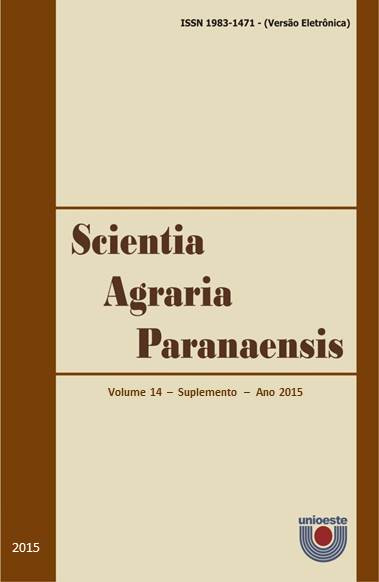Forage accumulation and morphogenetic and structural characteristics of Axonopus aureus in the Roraima´s savanna
DOI:
https://doi.org/10.18188/sap.v14i0.11757Keywords:
Crescimento, perfilhamento, rebrota.Abstract
The effects of cutting plant age (21, 28, 35, 42, 49, 56, 63 and 70 days) on dry matter (DM) yield, and morphogenetic and structural characteristics of Axonopus aureus, during rainy season, were evaluated under natural field conditions. The experimental design was a completely randomized, with three replications. Evaluations were carried out during the period of June to August 2009. DM yield, absolute growth rate (AGR), number of tillers plant-1, number of leafs plant-1, leaf area, leaf senescence and elongation rates and blade length increased consistently with growth stage. The relations between DM yield and AGR with cutting plants age were described by the quadratic regression model. The maximum DM yield and forage production rate performance were estimated at 62.7 and 49.4 days of regrowth. The crop growth and relative growth rates, tiller and leaf appearance rates were inversely proportional to cutting plant age. These data suggest that cutting at 49 to 56 days were optimal for obtain maximum dry matter yields and improved the grass morphogenetic and structural characteristics.
Downloads
Published
How to Cite
Issue
Section
License
Aviso de Direito Autoral Creative Commons
Política para Periódicos de Acesso Livre
Autores que publicam nesta revista concordam com os seguintes termos:
1. Autores mantém os direitos autorais e concedem à revista o direito de primeira publicação, com o trabalho simultaneamente licenciado sob a Licença Creative Commons Attribution que permite o compartilhamento do trabalho com reconhecimento da autoria e publicação inicial nesta revista.2. Autores têm autorização para assumir contratos adicionais separadamente, para distribuição não-exclusiva da versão do trabalho publicada nesta revista (ex.: publicar em repositório institucional ou como capítulo de livro), com reconhecimento de autoria e publicação inicial nesta revista.
3. Autores têm permissão e são estimulados a publicar e distribuir seu trabalho online (ex.: em repositórios institucionais ou na sua página pessoal) a qualquer ponto antes ou durante o processo editorial, já que isso pode gerar alterações produtivas, bem como aumentar o impacto e a citação do trabalho publicado (Veja O Efeito do Acesso Livre).
Licença Creative Commons
Esta obra está licenciada com uma Licença Creative Commons Atribuição-NãoComercial-CompartilhaIgual 4.0 Internacional, o que permite compartilhar, copiar, distribuir, exibir, reproduzir, a totalidade ou partes desde que não tenha objetivo comercial e sejam citados os autores e a fonte.


